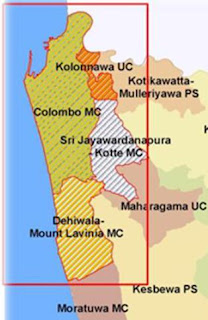08th March 2012, www.island.lk, By Harischandra Gunaratna
Jaffna Hoteliers Association (JHA) Chairman Mariyadas Kisho predicts that tourism will be the mainstay in Jaffna’s economy soon and sees the urgent need is the establish a Satellite Hotel School in the northern capital.

Kisho, a
Ceylon Hotel School graduate and a student of the now defunct first government sponsored Satelite Hotel School in Jaffna said that since there was a dearth of trained personnel in the Northern Province, hotel owners were compelled to employ staff from Colombo and other areas.
"This has resulted in overheads being quite high ," he said.
If the government opened a Satelite Hotel School in Jaffna it would lead to providing a lot of employment opportunities to the northern youth as the tourism industry was fast developing whith more and more hotels and guest houses being opened, he said.
"There are a number of boys and girls who have just failed to gain entrance to the universities and are unemployed, in the Northern Province and they can be absorbed into the hospitality industry if there is a recognised hotel school to provide them training," The JHA Chairman said adding that "There is an abundance of talent in the area and what is required is proper training and guidance."
Kisho was critical about the previous Satelite Hotel School established by the government in 2002 and said that "The government should not establish a Satelite Hotel Schools in haphazard manner just for the sake of doing it. The one established by the then government in 2001 became a failure and had to be closed down after one year of operation as the government authorities without doing any feasibility study simply started a hotel school merely as a propaganda tool."
The authorities should have created an awareness about such a venture before starting a hotel school, which was a dire need even at that time as there were many children who wanted to join the hospitality industry but lacked opportunities, he noted.
JHA Chairman pointedout that"They should have also given thought to the cultural sensitivities of the Tamils in this part of Sri Lanka." he pointed out.
The young hotelier was of the opinion that the government should provide more tax concessions to industrialists including hoteliers to encourage more investments.
"The government has now relaxed the restriction on foreigners travelling to the North with the much of the area having been de-mined and there is a great influx of tourists visiting the area," he said.
Although land prices had sky rocketed in the north, specially in the Jaffna town limits,Kisho said there are a large number of investors both foreign and local who had either purchased or leased out land, started construction of hotels and guest houses. The land prices had increased tenfold from what it was in the pre-2009 era, he said.
Asked whether there was enough land available for tourism related projects, he answered in the affirmative and added land was not an issue but prices had increased due to the ever increasing demand.
A number of companies and individuals which included foreign investors had begun construction in the north while a few were already in operation.
"There is a huge demand for rooms from foreigners as well as domestic tourists and the number of units available are well below the requirement and demand is on the increase," Kisho said.
He said,the government was encouraging more investments and some of the islets in the Northern peninsula had been earmarked for tourism development with an airport being constructed in Delft, which was the largest of the islets.
"In these islets one could not construct multi storeyed hotels, but what is best suited are eco-friendly chalets and the government is targetting high-end tourists to the islets," he explained.
There is also a luxury fast boat service from Kurikattuwan near Nainativu (Nagadeepa) to Delft as many tourists with a majority of them domestic travellers have started visiting the islet.
Explaining about the other tourism development projects in the north, Kisho said that one or the most sought after beaches in the Jaffna Peninsula was Casurina beach at Karainagar, a narrow stretch of beach with pure white sand. Local investors numbering four to five have purchased land in the area for tourism development and construction would begin soon, he said.
A US$ 20 million project where a number of high-end beach chalets were being built by a London investor at the popular Chatty beach in Kyts while a three star hotel was also constructed there by another, he said.
There were about 15 hotels and guest houses in and around Jaffna functioning at present and Green Grass and Tilco Jaffna City Hotel were some of the new hotels that are in operation in the town with Gnanams which has been there for a long period, he explained.
"There aren’t big hotels in Jaffna yet and what is available are small hotels and guest houses where each will have about 50 rooms maximum," he added.
Nagadeepa (Nainativu) another islet that the government should look at developing for religious tourism as there was a famous Buddhist temple and a Hindu Kovil visited by thousands of devotees. The tourism authorities should invite investors to construct a few guest houses and motels on this small islet.
Related Info :•
15 Story Star Class Hotel in Jaffna as Sri Lanka's Northern Province Develops Rapidly. The Hotel Yarl Jetwing is a Joint Venture between Mercantile Merchant Bank Ltd and Jetwing Group•
Palaly to be Made an International Airport for Regional Passengers to Sri Lanka. Rs 1bn Allocated for Northern Development
 Efforts are being made by the port agency, vessel operators and other stakeholders to resume the ferry operations between the two countries.
Efforts are being made by the port agency, vessel operators and other stakeholders to resume the ferry operations between the two countries.















































